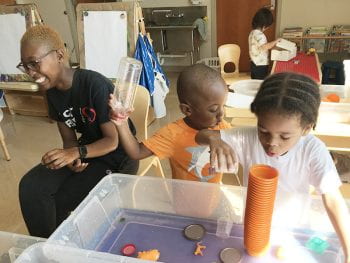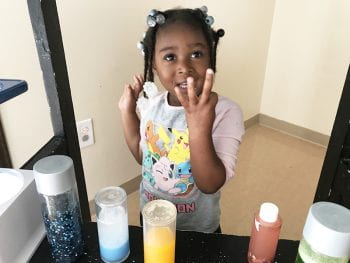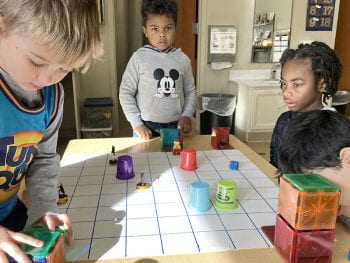What things do you need to open up a restaurant? That depends on who you ask.
If you’re consulting a room full of three-year-olds, you might be surprised to learn that menus, dishes, even food, are not top of mind. Dawn Pulsipher, a longtime studio teacher at Julia Goldstein Early Childhood Education Center (JG) recently learned from her young entrepreneurs that there’s something far more essential to the dining experience: crayons.
“Crayons! Of course!” she says with a laugh. “If you think about it, this makes perfect sense. Having crayons and paper brought to the table is a big part of how children this age have experienced restaurants thus far. Kids bring in their knowledge to each experience, and knowledge is socially constructive.”
Pulsipher and her JG colleagues dedicate considerable energy to clarifying just how their young learners come to understand things. Recording conversations, taking videos and photos, collecting student work, the staff gather any clues that offer a peek into a window of what a child is thinking. Observation and documentation at this level is driven by the school’s Reggio-inspired approach, which the school’s principal, Crystal Cauley, describes as a way of thinking about children that requires a mental shift, especially for educators more accustomed to being in the driver’s seat in the classroom.

“Children are highly capable and can drive the work of learning,” says Cauley. “Our approach doesn’t replace the need for planning, but it does fuel our work.”
Pulsipher confirms that students really do take the lead on learning when provided tools and spaces to do what they naturally do: discover.
“We offer students lots of opportunities and see where their natural interests lie,” Pulsipher explains. “It’s like a ball being tossed back and forth. As teachers, we’re responsible for setting up the environment to see how they’ll react.”
Bring on the math
Letting children take the lead doesn’t mean a classroom free-for-all. On the contrary, say Pulsipher, Cauley and the rest of the teaching team at Julia Goldstein, who confirm that young children naturally gravitate toward skills and topics we want them to master, including math.
“Research tells us that engaging in a STEM-rich environment as early as preschool motivates and sparks interest in learners that leads to greater future outcomes in all subjects.”
Victoria May, ISP executive director
“It’s all about offering the right environment and really inviting materials,” says Pulsipher. She wears many hats in the school, including garden coordinator and part of the team that created the mud kitchen, an outdoor playspace. “If I provide multiple, aesthetically-pleasing bowls, the children are going to react. We’ve been asking ourselves an interesting question: how will students respond to loose parts so we can understand how math naturally occurs during play? I still find myself being surprised with what they come up with. They have ideas that we teachers haven’t considered.”

So where’s the math? Turns out, it’s everywhere. And with support from the Institute for School Partnership at Washington University in St. Louis (ISP), the JG teaching team is receiving
support, skills and structures needed to weave critical math concepts into project-based learning.
Supporting high-quality math experiences for early learners is at the heart of the Math314 Early Childhood Mathematics Research Partnership, a research practice partnership launched in Fall 2021 by ISP and Julia Goldstein.
“Research tells us that engaging in a STEM-rich environment as early as preschool motivates and sparks interest in learners that leads to greater future outcomes in all subjects,” says ISP Executive Director Victoria May. “To build a pipeline of young learners who are poised to view math as an integral and natural part of their world is at the core of ISP’s commitment to equitable learning, so our partnership with colleagues at Julia Goldstein is proving a valuable effort all around. We’re learning as much from this team as they are learning from us.”
The key to success, says May, is ISP’s overarching approach to partnership and coaching, which prioritizes building and nurturing of relationships.
“We serve as a thought partner for planning first, and critical friend/observer next,” she says.
ISP Math Instructional Specialist Joslyn Richardson serves in a boots-on-the-ground capacity with the partnership, responsible for everything from design to implementation of coaching activities with the JC staff. She embraces her role as thought partner, which has made it possible to be responsive to the school’s unique needs.
“My approach is getting to know the teachers one-on-one as a coach, resource and sounding board,” says Richardson, whose work has focused on strengthening mindsets around math teaching and learning, as well as shoring up the project’s grounding in data.

Richardson works especially closely with Pulsipher and another teacher, Corrie Hamilton. The two have been assigned as the school’s teacher researchers. In that role, they are responsible for not only learning new skills themselves, but also sharing what they learn as coaches to peers throughout the building.
“We want all of our teachers to understand not only the learning progression of children, but also how to support that, to recognize when children are struggling and know what skills they need to learn, where to go next when students have mastered something,” says Cauley, who credits the partnership with ISP for strides made thus far.
“Coaching is just like teaching,” she says. “It’s a gradual release of the wheel. In Year One, a lot of the load was on ISP. This second year, there’s been more trust building and modeling. Up next is release and support.”
Read more about ISP’s approach to coaching here.
